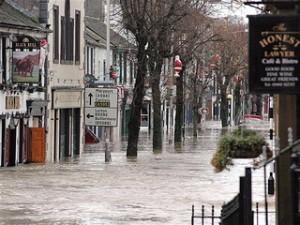Flooding is a fact of life. To take advantage of natural sources of hydration and ready-made trade links, humanity has historically clustered near large, volatile bodies of water. During the past several thousand years, cities and towns have sprung up on barrier islands and around saltwater harbors, inland lakes and lazy river bends. Overall, this mode of development has served trade and commerce quite well.

Unfortunately, it has also produced its share of misery and despair. From the low-lying plains of the Netherlands to the river towns of the American heartland, periodic floods have washed away entire cities and killed countless human beings. In the process, these disasters have wiped away homes and businesses worth trillions of dollars in the aggregate. Over the relatively short span of American history, dozens of disasters like the Johnstown Flood of 1889 and the Mississippi-Missouri River Floods of 1993 have wreaked havoc on local economies and destroyed thousands of families and livelihoods.
It would seem logical that the American insurance industry would stand ready to protect the country’s families against seemingly inevitable flood-wrought carnage. Unfortunately, very few homeowner’s insurance policies offer flood protection any longer. Those that continue to do so have become all but unaffordable for regular middle-class families. These days, homeowners who wish to protect their homes and possessions from the potential ravages of a flood typically must purchase standalone flood insurance policies or expensive “riders” on their existing homeowner’s insurance policies.
There are several reasons for this trend.
First, flood insurance claims don’t follow the pattern common to most other types of insurance. An examination of car accident claims illustrates this point nicely. Since the national accident rate is liable to hold steady or decline slightly over long periods of time, an auto insurer can use straightforward calculations to determine the likelihood that any single policyholder will make a damage claim during a given year. Using this baseline metric, the insurer can then accurately estimate the total value of the payouts that it’s likely to issue within that same period. Although this is a slight oversimplification, the basic math holds true.
By contrast, flood insurance claims tend to come in waves. This is attributable to basic facts of geology and hydrology: Since water seeks the lowest level, it tends to spread along low-lying surface contours. Along the way, it damages and destroys the buildings and infrastructure features that stand in its path. An auto insurer might find it highly unlikely that 50 of its policyholders would file damage claims arising from near-simultaneous accidents in a tightly-defined geographical area. On the other hand, a flood insurer would be reckless not to expect such a “cluster” of claims.
Since floods tend to affect broad geographical areas and ensnare hundreds or even thousands of homeowners in the same costly event, they’re an actuarial nightmare. Since the study of climatology dictates that certain areas are likely to receive regular floods, insurance companies are faced with an unpleasant binary choice. They must either resign themselves to making massive periodic claims payouts that devastate their bottom lines or refuse to cover homeowners who require protection against the catastrophic floods that they know must eventually come.
It’s important to note that even those providers that choose the former option tend to impose certain restrictions on their new policyholders. Chief among these is a mandatory “waiting period” that’s designed to prevent homeowners from timing their flood insurance purchases to coincide with catastrophic weather events. At 30 days, this waiting period is far longer than the seven-day window during which storm-track predictions are considered to be accurate.
Both those insurance companies that refuse to issue flood coverage as part of their homeowner’s policies and those that charge exorbitant premiums for such coverage appear to be well-positioned for the future. Thanks to the increasing frequency of river flooding and the growing vulnerability of oceanfront areas to major coastal storms, it’s all but certain that flood-related costs will continue to rise in the coming years.
For obvious reasons, the cost of flood coverage varies considerably. For instance, it may cost over $400 per year to insure a median-value Florida home that has a “low to moderate” flood risk. By contrast, it can cost $2,000 or more to insure median-value homes in low-lying districts of flood-prone river towns like Scranton, Pennsylvania.
What’s more, wet years during which insurance companies must pay out on large numbers of claims can have lasting effects. After devastating events, flood insurers typically issue across-the-board premium increases in affected areas. At 10 percent or more per year, these increases can easily outpace the rate of inflation. As storms like Katrina and Sandy become commonplace, it’s fair to assume that these insurers will continue to put financial pressure on flood-prone homeowners. Ultimately, this trend could have major implications for the housing development patterns that currently define the country’s geography.
While the wholesale abandonment of established low-lying cities is unlikely, the construction of formidable dikes, dams and levees may be required to keep the flood-waters at bay in places like New Orleans, St. Louis and Miami. Further, many local governments may take it upon themselves to ban residential development on known floodplains or vulnerable barrier islands. Over the long term, these two trends could serve to blunt the impact of rising flood coverage premiums and may encourage the nation’s insurance companies to treat flood-prone homeowners with compassion.
See also:
- Articles on Your Family Finances related to Homeowner’s Insurance
- Five Important Things about Your Homeowners Insurance Contract
Insurance-related Resources:
- Insurance for Dummies
- Be Insurance Savvy: Home, Auto, Dwelling, Renter’s, Flood and other Personal Insurance Explained (Volume 1)
- Home Buying Kit For Dummies
Photo credit: “Flooding” by University of Salford / Flickr



